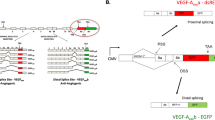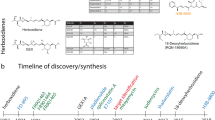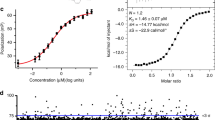Abstract
Pladienolide is a naturally occurring antitumor macrolide that was discovered by using a cell-based reporter gene expression assay controlled by the human vascular endothelial growth factor promoter1,2. Despite the unique mechanisms of action3 and prominent antitumor activities of pladienolides B and D in diverse in vitro and in vivo systems3, their target protein has remained unclear. We used 3H-labeled, fluorescence-tagged and photoaffinity/biotin (PB)-tagged 'chemical probes' to identify a 140-kDa protein in splicing factor SF3b as the binding target of pladienolide. Immunoblotting of an enhanced green fluorescent protein fusion protein of SF3b subunit 3 (SAP130) revealed direct interaction between the PB probe and SAP130. The binding affinities of pladienolide derivatives to the SF3b complex were highly correlated with their inhibitory activities against reporter gene expression and cell proliferation. Furthermore, pladienolide B impaired in vivo splicing in a dose-dependent manner. Our results demonstrate that the SF3b complex is a pharmacologically relevant protein target of pladienolide and suggest that this splicing factor is a potential antitumor drug target.
This is a preview of subscription content, access via your institution
Access options
Subscribe to this journal
Receive 12 print issues and online access
$259.00 per year
only $21.58 per issue
Buy this article
- Purchase on Springer Link
- Instant access to full article PDF
Prices may be subject to local taxes which are calculated during checkout





Similar content being viewed by others
References
Sakai, T. et al. Pladienolides, new substances from culture of Streptomyces platensis Mer-11107. I. Taxonomy, fermentation, isolation and screening. J. Antibiot. (Tokyo) 57, 173–179 (2004).
Sakai, T., Asai, N., Okuda, A., Kawamura, N. & Mizui, Y. Pladienolides, new substances from culture of Streptomyces platensis Mer-11107. II. Physico-chemical properties and structure elucidation. J. Antibiot. (Tokyo) 57, 180–187 (2004).
Mizui, Y. et al. Pladienolides, new substances from culture of Streptomyces platensis Mer-11107. III. In vitro and in vivo antitumor activities. J. Antibiot. (Tokyo) 57, 188–196 (2004).
Burdine, L. & Kodadek, T. Target identification in chemical genetics: the (often) missing link. Chem. Biol. 11, 593–597 (2004).
Harding, M.W., Galat, A., Uehling, D.E. & Schreiber, S.L. A receptor for the immunosuppressant FK506 is a cis-trans peptidyl-prolyl isomerase. Nature 341, 758–769 (1989).
Yoshida, M., Horinouchi, S. & Beppu, T. Trichostatin A and trapoxin: novel chemical probes for the role of histone acetylation in chromatin structure and function. Bioessays 17, 423–430 (1995).
Taunton, J., Hassig, C.A. & Schreiber, S.L. A mammalian histone deacetylase related to the yeast transcriptional regulator Rpd3p. Science 272, 408–411 (1996).
Fenteany, G. et al. Inhibition of proteasome activities and subunit-specific amino-terminal threonine modification by lactacystin. Science 268, 726–731 (1995).
Iwata, M. et al. E7107, a new urethane derivative of pladienolide D, displays curative effect against several human tumor xenografts. Proc. Am. Assoc. Cancer Res. 45, 691 (2004).
Kotake, Y. et al. in Program and Proceedings of the AACR-NCI-EORTC International Conference (Boston, Massachusetts, USA, 17–21 November, 2003) 189 (AACR-NCI-EORTC, 2003).
Taunton, J., Collins, J.L. & Schreiber, S.L. Synthesis of natural and modified trapoxins, useful reagents for exploring histone deacetylase function. J. Am. Chem. Soc. 118, 10412–10422 (1996).
Hall, L.L., Smith, K.P., Byron, M. & Lawrence, J.B. Molecular anatomy of a speckle. Anat. Rec. A Discov. Mol. Cell Evol. Biol. 288A, 664–675 (2006).
Lührmann, R., Kastner, B. & Bach, M. Structure of spliceosomal snRNPs and their role in pre-mRNA splicing. Biochim. Biophys. Acta 1087, 265–292 (1990).
Jurica, M.S. & Moore, M.J. Pre-mRNA splicing: awash in a sea of proteins. Mol. Cell 12, 5–14 (2003).
Staley, J.P. & Guthrie, C. Mechanical devices of spliceosome: motors, clocks, springs, and things. Cell 92, 315–326 (1998).
Price, S.R., Evans, P.R. & Nagai, K. Crystal structure of the spliceosomal U2B′′-U2A′ protein complex bound to a fragment of U2 small nuclear RNA. Nature 394, 645–650 (1998).
Will, C.L. et al. A novel U2 and U11/U12 snRNP prtein that associates with the pre-mRNA branch site. EMBO J. 20, 4536–4546 (2001).
Golas, M.M., Sander, B., Will, C.L., Lührmann, R. & Stark, H. Molecular architecture of the multiprotein splicing factor SF3b. Science 300, 980–984 (2003).
Seghezzi, W. et al. Cyclin E associates with components of the pre-mRNA splicing machinery in mammalian cells. Mol. Cell. Biol. 18, 4526–4536 (1998).
Loyer, P., Trembley, J.H., Lahti, J.M. & Kidd, V.J. The RNP protein, RNPS1, associates with specific isoforms of the p34cdc2-related PITSLRE protein kinase in vivo. J. Cell Sci. 111, 1495–1506 (1998).
O'Keefe, R.T., Mayeda, A., Sadowski, C.L., Krainer, A.R. & Spector, D.L. Disruption of pre-mRNA splicing in vivo results in reorganization of splicing factors. J. Cell Biol. 124, 249–260 (1994).
Proudfoot, N.J., Furger, A. & Dye, M.J. Integrating mRNA processing with transcription. Cell 108, 501–512 (2002).
Maniatis, T. & Reed, R. An extensive network of coupling among gene expression machines. Nature 416, 499–506 (2002).
Acknowledgements
We thank T. Tsuchida (Mercian Corporation Bioresource Laboratories) for supplying pladienolide B, T. Satoh for helpful technical advice, M. Date for experimental assistance and N. Asai and M. Gomibuchi for spectral analysis of the chemicals. We are grateful to K. Yoshimatsu, M. Asada, T. Nagasu and J. Kuromitsu for coordinating the research team.
Author information
Authors and Affiliations
Contributions
Y.K. designed and performed research and wrote the manuscript; K.S. designed and performed research; T.O. designed and performed research; Y.M.-K. designed and performed research; H.S. performed research; M.U. performed research; Y.I. performed research; M.I. performed research; Y.M. designed and performed research and provided overall direction.
Corresponding author
Ethics declarations
Competing interests
Y.K., K.S., T.O., H.S., M.U., M.I. and Y.M. work for and have financial interests in Eisai Co. Ltd., a pharmaceutical company that is pursuing the clinical development of E7107. Y.M.K. works for and has financial interests in KAN Research Institute Inc., a subsidiary company of Eisai. Y.I. has no competing financial interests.
Supplementary information
Supplementary Text and Figures
Supplementary Figures 1–9, Supplementary Tables 1–4 and Supplementary Methods (PDF 652 kb)
Rights and permissions
About this article
Cite this article
Kotake, Y., Sagane, K., Owa, T. et al. Splicing factor SF3b as a target of the antitumor natural product pladienolide. Nat Chem Biol 3, 570–575 (2007). https://doi.org/10.1038/nchembio.2007.16
Received:
Accepted:
Published:
Issue Date:
DOI: https://doi.org/10.1038/nchembio.2007.16
This article is cited by
-
Enhanced mapping of small-molecule binding sites in cells
Nature Chemical Biology (2024)
-
Target identification of small molecules: an overview of the current applications in drug discovery
BMC Biotechnology (2023)
-
Inhibition of SF3B1 improves the immune microenvironment through pyroptosis and synergizes with αPDL1 in ovarian cancer
Cell Death & Disease (2023)
-
Shell protein composition specified by the lncRNA NEAT1 domains dictates the formation of paraspeckles as distinct membraneless organelles
Nature Cell Biology (2023)
-
Spatial organization of transcribed eukaryotic genes
Nature Cell Biology (2022)



